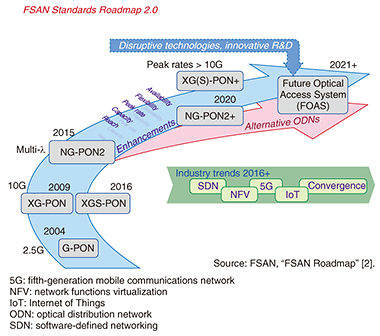 |
|||||||
|
|
|||||||
|
Global Standardization Activities Vol. 15, No. 10, pp. 60–64, Oct. 2017. https://doi.org/10.53829/ntr201710gls Standardization Trends for Future High-speed Passive Optical NetworksAbstractStandardization organizations are conducting studies on optical networks with higher-than-ever speeds as part of efforts to continue the development of access networks. This article briefly reviews the general concept of the latest high-speed passive optical network system called NG-PON2 (Next-Generation Passive Optical Network Stage 2) and introduces current standardization trends for future high-speed optical access systems. Keywords: passive optical network, NG-PON2, 100G-EPON 1. Standardization of optical access systemsPassive optical networks (PONs) are being widely utilized to provide optical broadband services to many users in a cost-effective manner. They consist of a point-to-multipoint topology in which an optical line terminal (OLT) is placed at the central office and connected to multiple optical network units (ONUs) placed at each user’s home through a feeder fiber and an optical splitter. Current PON systems employ time division multiplexing and time division multiple access (TDM/TDMA) because the OLT and part of the feeder fiber can be shared by many users. In such PONs, each ONU communicates with the OLT in different time slots assigned by the OLT. Standardization of 1-Gbit/s to 10-Gbit/s-class PONs has already been completed by both the Institute of Electrical and Electronics Engineers (IEEE) and the International Telecommunication Union - Telecommunication Standardization Sector (ITU-T). Likewise, IEEE has completed the standardization of GE-PON (Gigabit Ethernet PON) and 10 Gigabit Ethernet PON (10G-EPON), and ITU-T has done so for Gigabit-capable PON (G-PON), 10 Gigabit-capable PON (XG-PON), and 10 Gigabit-capable symmetric PON (XGS-PON). ITU-T has also standardized the 40-Gbit/s-class PON system called the Next-Generation Passive Optical Network Stage 2 (NG-PON2) for a further increase in total capacity. The basic approach of NG-PON2 is time and wavelength division multiplexing (TWDM)-PON, which is a hybrid of conventional TDM/TDMA and wavelength division multiplexing (WDM) technologies and can increase the aggregated PON rate beyond 10 Gbit/s. This article briefly reviews the basic concept of NG-PON2—the latest high-speed PON system—and introduces the current standardization trends for future high-speed optical access systems being discussed in IEEE, ITU-T, and the Full Service Access Network (FSAN) Group, which has contributed to the standardization of G-PON, XG(S)-PON, and NG-PON2. 2. NG-PON2An example of the 40-Gbit/s-class optical access system called NG-PON2 is shown in Fig. 1. Standardization of this system was completed in July 2015 by ITU-T. While previous PON systems mainly offer broadband services for residential users, NG-PON2 systems are expected to accommodate both business and residential users; they will also accommodate mobile antennas.
As mentioned in the previous section, TWDM-PON is adopted as the primary technology. NG-PON2 supports PtP (point-to-point) WDM overlay, in which each ONU communicates with the OLT using an assigned wavelength channel that is occupied by the ONU. There are four, optionally eight, multiplexed wavelengths for both upstream and downstream communications. In an NG-PON2 network, there are three line rates (per wavelength): symmetrical 10 Gbit/s, 2.5 Gbit/s (upstream) and 10 Gbit/s (downstream), and symmetrical 2.5 Gbit/s. When symmetrical 10 Gbit/s is utilized, the NG-PON2 system offers a symmetrical maximum transmission capacity of 40 Gbit/s. The maximum split ratio and transmission distance are specified as 1:256 and 40 km, respectively. One of the main advances of the NG-PON2 system is its use of wavelength tuning in the ONU. In-service ONU wavelength tuning enables the NG-PON2 system to offer advanced network functions. For example, dynamic wavelength assignment offers ONU traffic load balancing by adjusting the numbers of ONUs assigned to each wavelength, as well as protection of OLT cards, in which the malfunction of an OLT card triggers immediate ONU wavelength reassignment. 3. IEEE 100G-EPONTo elucidate the latest trends in high-speed PON systems that offer a total capacity over 40 Gbit/s, we introduce the standardization activities of IEEE for a 100-Gbit/s-class Ethernet PON system. In December 2015, IEEE confirmed the establishment of the IEEE 802.3ca Task Force (TF), which started work on standardizing 100G-EPON with the aim of completing it by 2020 [1]. An example of the 100G-EPON system under discussion in 802.3ca TF is shown in Fig. 2. It is assumed that 100G-EPON will adopt WDM technology, just as with NG-PON2. The consensus for the basic 100G-EPON is that the line rate per wavelength and the maximum number of multiplexed wavelengths will be 25 Gbit/s and four wavelengths, respectively. In addition, it has also been decided that non-return-to-zero modulation (used in previous PON systems) will be adopted at the transmitter.
To offer an incremental upgrade of maximum transmission capacity from 25 Gbit/s to 100 Gbit/s for downstream and 10 Gbit/s to 100 Gbit/s for upstream, seven types of ONUs are expected to be used in the 100G-EPON system: 25/10G-ONU, 25/25G-ONU, 50/25G-ONU, 50/50G-ONU, 100/25G-ONU, 100G/50G-ONU, and 100/100G-ONU. Additionally, IEEE 802.3ca TF will begin studying optional configurations of 50G-EPON and 100G-EPON, where the line rate per wavelength is 50 Gbit/s, and the maximum number of multiplexed wavelengths is two. A conceptual image of the incremental ONU upgrade in 100G-EPON downstream is also shown in Fig. 2. Three types of ONUs are illustrated: a 25G-ONU, 50G-ONU, and 100G-ONU. Each ONU receives downstream signals using assigned wavelength channels (the line rate per wavelength is 25 Gbit/s); 25G-ONU receives λ1, 50G-ONU receives both λ1 and λ2, and 100G-ONU receives all wavelength channels λ1–4. A total capacity of 50 Gbit/s and 100 Gbit/s is respectively achieved by channel bonding the two and four wavelengths received. A 100G-EPON wavelength plan assumed by IEEE 802.3ca TF is shown in Fig. 3. For comparison, wavebands of current PON systems are also summarized. Since increasing the signal bandwidth makes optical fiber dispersion much worse, the use of the O-band (1260 nm to 1360 nm, around the zero dispersion wavelength) for both upstream and downstream has been agreed on to suppress the penalty of signal waveform distortion caused by optical fiber dispersion.
Note that the waveband is also assigned to conventional 1-Gbit/s and 10-Gbit/s-class PON systems. For the present, a precise wavelength plan for 100G-EPON is still under study in IEEE 802.3ca TF. However, it has been agreed that 100G-EPON will co-exist with 10G-EPON and G-PON using a set of reduced wavelengths. There are two main options to offer co-existence with the use of WDM; one option is for the first 25G-ONU wavelength channel to use the waveband at 1310 nm with a 20-nm width and to co-exist with 10G-EPON. The other option is for the first 25G-ONU wavelength channel to use a 20-nm-wide waveband at 1270 nm and to co-exist with G-PON using a set of reduced wavelengths. IEEE 802.3ca TF is aiming to conclude the IEEE standard 802.3ca by April 2020 and will focus on discussing details of the specifications for the physical layer, ONU control plane, and transmission convergence layer in the near future. 4. Further enhancement of XGS-PON and NG-PON2 by FSAN/ITU-TFSAN and ITU-T recently initiated a study on enhancing the capability of 10-Gbit/s per wavelength class PON systems such as NG-PON2 and XGS-PON. Other targets include further improvement in the line rate per wavelength beyond 10 Gbit/s as one of the study options. FSAN released a standardization roadmap in November 2016, shown in Fig. 4 [2]. This roadmap predicts that the future optical access system will have to offer not only higher maximum transmission capacity but also several new attributes such as long reach and high splitting ratios, system reconfigurability and flexibility, and high availability of network equipment. The emergence of high-speed mobile services such as 5G (fifth-generation mobile communications network) and the development of software-defined networking and network functions virtualization technologies are also expected to push these trends.
At the same time, ITU-T Study Group 15 (SG15) has commenced work on “G.sup.HSP: G. Supplement High-Speed PON,” a technical supplement on the current technologies available for improving the PON system line rate per wavelength to beyond 10 Gbit/s [3]. FSAN member companies are offering their contributions to ITU-T SG15 to promote the development of the future optical access system. 5. SummaryThis article reviewed the latest standardization trends to achieve further increases in the bandwidth of PON systems. IEEE, FSAN/ITU-T, and the Broadband Forum have initiated studies into PON convergence in order to prevent conflicts in the standardization activities for high-speed PON systems. We expect these activities to lead to the further evolution of optical access systems and sustain the continuous development of broadband services. References
|
|||||||
















